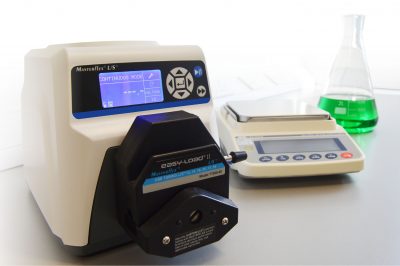So wählen Sie die richtige Dosierungsmethode für Ihren Flüssigkeitsprozess
Gravimetric vs Volumetric
Ensured accuracy in the fluid dispensing or dosing system is critical to the success of many processes and experiments—from making sure the right amount of crushed tomatoes is added in a spaghetti sauce recipe to dispensing life-saving vaccines into vials. Although the critical volumes in these applications are different, they both rely on some method of metering products with some amount of measurable accuracy. The first step in bringing accuracy to a fluid dispensing system, before even purchasing a pump, is to determine what accuracy is tolerable to your process or experiment. As the above applications illustrated, a lost drop of tomato liquid is not as impactful as a lost drop of vaccine.
Accuracy only follows measurability, so once a tolerance for dispensing accuracy is determined, choose a pump with a measurable output mechanically tied to the motor RPM, otherwise known as a metering pump. Choosing a metering pump such as a peristaltic or diaphragm system is a step in the right direction because metering pumps provide a reliable pattern of “fluid pockets” per revolution. The pump output can be determined mathematically using the volume of the fluid displaced and the motor RPM. Accuracy and resolution of the motor RPM is critical, so choose a pump drive within your determined tolerance for dispensing.

However, this is still a theoretical determination and may not reflect the actual system flow rate. Many factors such as part wear, back pressure (such as from filters or bag fill), fluid friction, and viscosity can affect flow rate and therefore dispensing accuracy. The discrepancy between the theoretical flow rate and the actual is usually minimal and within the acceptable limits of many labs and process floors. If the application is extremely sensitive to dosage, such as the direct value of pharmaceutical biologics and mining slurries or the sensitivity of cell cultures and agricultural crops to additives in the feed, added assurance of accuracy is extremely important. Knowing the exact amount dispensed— and in real time—reduces product waste and produces cost savings.
Generally, there are two methods of measurement: gravimetric and volumetric. The former is the measurement of the product by weight and involves a balance. The latter is by the volume of the liquid dispensed which involves a flow sensor placed downstream from the pump. Each has its own benefits particular to the application.

If measuring by weight, choose gravimetric. If measuring by volume, choose volumetric. However, there are other benefits and disadvantages to each system. Gravimetric systems integrate a balance which is commonplace for laboratories and are reasonably accurate. However, many find it difficult to design a system able to properly and reliably communicate between the balance and the pump. Additionally, some gravimetric systems are able to directly measure in drop-by-drop resolution because of the balance sensitivity, making them ideal for the most sensitive dispensing applications. Volumetric systems can be added to existing systems via clamp-on sensor while others offer direct flow measurement via turbine sensor. However, they do not account for inconsistencies in density so if your pumping a product with various particulates a gravimetric system is a better choice.
Watch the Masterflex Gravimetric System deliver accuracy to the last drop
Masterflex® offers both gravimetric and volumetric dosing equipment consisting of three components: pump system, sensor, and controller, the pump systems have been designed with features that make it easy to integrate into your fluidics system.
What about extra drops?
If you are concerned about extra drops into your end product or container, here are some quick solutions:
- Make sure the tubing is clean. Buildup can affect the cohesive forces creating a welcoming surface for droplets.
- Install a filling nozzle. Although the above still applies here, these nozzles are easier to clean and their geometry makes droplets more predictable, therefore easier to control.
- Use a Masterflex pump. Masterflex pumps manufactured today feature anti-drip technology which briefly reverses the motor at the end of every dispense cycle (rotation customized by the user).
If your application requires a different pump technology, the Masterflex drives with Quattroflow™ pump heads, Masterflex piston pumps, and Masterflex gear pump are all compatible and enhanced by the robust variety of Masterflex tubing formulations so the systems can be used in almost any dosing or metering application.